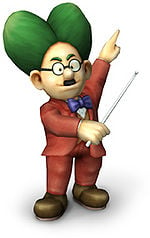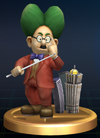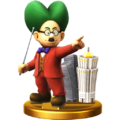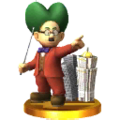SimCity (universe)
| SimCity (universe) | |
|---|---|
![SNES SimCity logo. From [1], cropped/cut-out by User:Reboot.](https://ssb.wiki.gallery/images/thumb/6/69/Sim_City_logo.png/200px-Sim_City_logo.png)
| |
| Developer(s) | Maxis Nintendo (SNES version) HAL Laboratory (N64 Version) |
| Publisher(s) | Nintendo (SNES and N64 versions) Maxis Electronic Arts |
| Designer(s) | Will Wright |
| Genre(s) | City-Building Simulation |
| Console/platform of origin | Amiga, Macintosh |
| First installment | SimCity (1989) |
| Latest installment | SimCity: BuildIt (2014) |
| Article on Wikipedia | SimCity (universe) |
The SimCity universe (シムシティー, SimCity) is a long-running series of open-ended world-simulation games developed by Maxis. Despite not creating or owning the series, the character of Dr. Wright is owned by Nintendo due to being exclusive to versions they developed, hence his inclusion in the Smash series.
Franchise Description
While working as a software developer for other companies, Will Wright showed a passion for level editors and wanted to create a game based entirely on the player creating their game with a level editor. He combined this desire with his fascination with urban planning to create a game based on creating and managing a city. This game, initially titled Micropolis before being changed to SimCity, was created in 1985 for Commodore 64, but went unreleased for years as every publisher turned the project down for being too complicated for the average consumer. Fed up with waiting for a publisher, Will and his friend Jeff Braun created their own in 1987, named Maxis. Commodore Amiga and Apple Macintosh versions of the game were also created around this time and were released first, with the Commodore 64 version releasing later.
The game was a critical and financial success, with particular praise given to its inventive gameplay, slick presentation and being an early example of a "Simulation" game. The game continued to sell for years afterwards and continued to receive accolades for aging very well as a game and as a simulation, with many proclaiming it as one of the most important video games of all time. The continued success is often attributed to its myriad of ports of just about every major game console and computer. A particularly notable port is the version for the Super Nintendo Entertainment System (simply called SimCity). This game introduced an original character named Dr. Wright, who acted as a tutorial character and introduced new game mechanics as necessary. Due to a licensing agreement, Dr. Wright is wholly owned by Nintendo and is not allowed to reappear in any future titles without permission. An NES version of the game was worked on nearly to completion, but was canceled for unknown reasons.
A sequel was eventually released in 1993, titled SimCity 2000. While fundamentally similar to its predecessor, this sequel saw a significant amount of improvements like improved graphics, more facilities and more mini-games. This game also received several ports, notably two versions for Nintendo 64. The first is a straightforward port released in 1997 with updated controls and graphics to be compatible with the system. The second is a modified version for Nintendo 64DD, titled SimCity 64 in 2000. This version is notable for the return of Mr. Wright, who has a similar role to previous appearances.
The series then introduced a slew of spinoff titles, including SimFarm, Sim City: The Card Game, SimTown, SimCopter, and Streets of SimCity before Maxis was purchased by Electronic Arts in 1997. The first game under their new parent company was SimCity 3000 in 1999. The game is the first in the series to have an original music score. The game also features a host of new facilities and city features. The team created another spinoff game a year later, titled The Sims, which takes the Sim formula and puts it on a much smaller scale with the player directly controlling individuals. The game was a massive success and spawned its own franchise that has become a tentpole property for Electronic Arts.
Another sequel, titled SimCity 4, released in 2003. The game is the first in the series to use 3D polygonal graphics and introduced various game modes to control the city at a macro and micro level. Later that year, the game received an expansion pack titled Rush Hour, as well as a deluxe edition that combined both releases. This expansion greatly expanded transportation, including the ability to directly control vehicles.
The series then received its first handheld title, titled SimCity DS for Nintendo DS. Based on SimCity 3000, the game was rebuilt to be used with a touch screen interface. The game was also the first to not be made by Maxis, instead being developed by AKI Corporation. That same year, Tilted Mill Entertainment developed SimCity Societies for PC. This game differs from previous entries in that it focused more on social engineering and was overall less strict on planning and roles. Hudson Soft then developed SimCity Creator in 2008 exclusively for Wii. This game utilized the Wii remote to construct the city more intuitively. A DS version of this game was also made with AKI returning, but it was not a port. It was instead a sequel to SimCity DS titled SimCity DS 2 in Japan that was renamed to avoid brand confusion. In 2012, an online version of the game was released on Facebook titled SimCity Social. The game lasted less than a year before shutting down in 2013.
All games mentioned that did not involve Maxis received mixed to negative reviews, with most critics agreeing that their absence was felt and very apparent. This is due to the company working on Spore, a history and evolution simulation game. Maxis finally returned to the series with SimCity, a complete reboot of the series in 2013. However, this release ended up being the most controversial entry in the series due to a myriad of problems and poor decisions. Aside from the many cut features, engine problems and performance issues, the game required the player to have a persistent internet connection while playing despite being an offline, single-player game. This caused problems with disconnections and loss of saved data, particularly when the online servers went down for several days, meaning no one was allowed to play the game during that time. The online mandate was eventually removed, and the Cities of Tomorrow expansion was released, but the game still has overall negative reviews.
The series has officially gone dormant, with the last release being a mobile game titled SimCity: BuildIt in 2014. The negative response of the game caused a large amount of the studio to be laid off, and now the development teams have only worked on The Sims 4 and its expansions since 2014.
In Super Smash Bros. Melee
Dr. Wright appears as a trophy in Super Smash Bros. Melee.
Trophy
Dr. Wright
- The assistant to the mayor of SimCity, Dr. Wright was actually named after the creator of the game. As a player, you'd have to use your wisdom and experience to give timely advice to the mayor; if you did a good job, the city prospered. Dr. Wright is one of the leaders in the all-time, bizarre Nintendo-game-hairstyle contest.
- SimCity, 8/91
In Super Smash Bros. Brawl
Assist Trophy
Dr. Wright: He has a more major role in Brawl, where he appears as an Assist Trophy. After performing a jump that deals extremely minor damage on an opponent, he will summon a skyscraper from the ground, which inflicts high damage and knockback on any opponent it hits. Occasionally, Dr. Wright can summon a skyscraper 3x the standard size, which is even more powerful.
Trophy
- Dr. Wright
- A hardworking assistant to the city mayor. He has distinctive hair and spectacles and a dapper moustache. Dr. Wright has a comprehensive knowledge of city government and is happy to give you tips to keep your city running smoothly. In the game, he tracks your city's status and gives you gifts. There was a character reminiscent of him in The Legend of Zelda: Link's Awakening.
: SimCity
In Super Smash Bros. 4
The SimCity series returns in Smash 4, with no changes given or removed between the two games.
Assist Trophy
Dr. Wright: Returns from Brawl as an Assist Trophy, still shown to raise a skyscraper from the stage to attack opponents.
Trophy
- Dr. Wright
This hardworking assistant is the most trustworthy partner a mayor could ask for. If trouble strikes your city, he'll be right there to offer advice. In Smash Bros., he'll attack by constructing a building in the middle of the battlefield. It's tough to aim but can launch your foes.
As the mayor's hardworking assistant, Dr. Wright will sometimes bring ideas to the table when it comes to the delicate art of city-building. Other times, he'll bring gifts! His gift to you in this game is an attack that makes a new building shoot up in the blink of a eye. Use it to become the architect of your enemy's destruction!
: SimCity (08/1991)
In Super Smash Bros. Ultimate
The SimCity series returns in Ultimate with an upgrade for Dr. Wright's attack when summoned.
Assist Trophy
Dr. Wright: Returns as an Assist Trophy again. This time, however, Dr. Wright is capable of creating a larger skyscraper if an opponent attempts to attack him as a counter measure, which deals more damage.
Spirit
Dr. Wright also appears as a spirit.
| No. | Image | Name | Type | Class | Cost | Ability |
|---|---|---|---|---|---|---|
| 1,149 | Dr. Wright | ★★★ | 3 | Ore Club Equipped |
Trivia
- SimCity is the only third-party universe to have a character in the Super Smash Bros. series that is created and owned by Nintendo.




